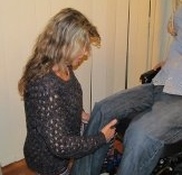What is The Bowen Technique ?
The Bowen Technique is a soft tissue remedial therapy, named after the man that developed the technique, Tom Bowen. To find out more about this remarkable man, or for any research information visit; www.thebowentechnique.com.
This technique is subtle, relaxing and gentle it involves NO hard or prolonged pressure, and is therefore suitable for all ages. It can also encompass pregnancy, infancy, the very elderly, infirm and for anyone who is unable to receive other therapies that are aggressive, invasive or forceful.
The Bowen Technique consists of rolling moves made over muscles, tendons and ligament's and is generally done in a sequence. Between sets of moves the body is left to rest for a couple of minutes and at this time the therapist may leave the room. This is know as, 'Bowen Breaks'. These are a key element of Bowen and are a defining aspect of this technique as well as being one of the most important. The breaks allow the body the opportunity to create a decision about what action needs to be taken in response to the moves given. This then helps to reduce pain, increase movement, improve function and experience peace of mine.
This technique is subtle, relaxing and gentle it involves NO hard or prolonged pressure, and is therefore suitable for all ages. It can also encompass pregnancy, infancy, the very elderly, infirm and for anyone who is unable to receive other therapies that are aggressive, invasive or forceful.
The Bowen Technique consists of rolling moves made over muscles, tendons and ligament's and is generally done in a sequence. Between sets of moves the body is left to rest for a couple of minutes and at this time the therapist may leave the room. This is know as, 'Bowen Breaks'. These are a key element of Bowen and are a defining aspect of this technique as well as being one of the most important. The breaks allow the body the opportunity to create a decision about what action needs to be taken in response to the moves given. This then helps to reduce pain, increase movement, improve function and experience peace of mine.
Most of the work is preformed through light clothing, although some therapist's do prefer to work on skin, the ultimate choice should be that of the client.
What to expect when having a treatment.
After filling out a medical history questionnaire and signing the privacy statement. Your therapist will then ask you detailed questions about your condition, pain, organic dysfunction's and physiological patterns. This would then be followed by a functional examination to find misalignments in the body, so the therapist can work out a treatment plan.
How many sessions will I need
Generally three sessions are booked one week apart. However, to determine how many sessions are required will depend on how acute or chronic the condition might be. In some acute cases only one treatment may be required.
After filling out a medical history questionnaire and signing the privacy statement. Your therapist will then ask you detailed questions about your condition, pain, organic dysfunction's and physiological patterns. This would then be followed by a functional examination to find misalignments in the body, so the therapist can work out a treatment plan.
How many sessions will I need
Generally three sessions are booked one week apart. However, to determine how many sessions are required will depend on how acute or chronic the condition might be. In some acute cases only one treatment may be required.





